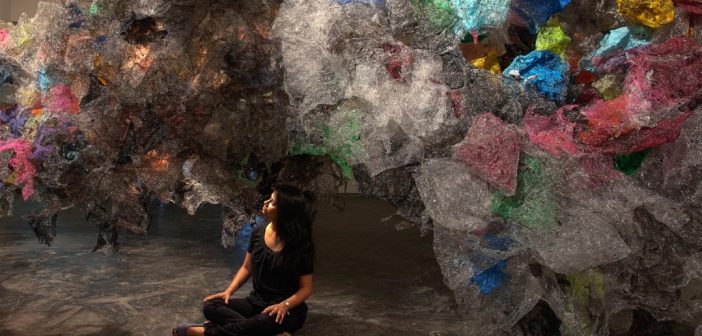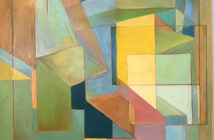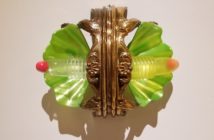When Aaditi Joshi was born in 1980, her hometown was called Bombay and was also home to about 8 million others. Today, it's Mumbai, the capital of Maharashtra and one of the largest cities in the world, with more than 12 million now living in the city. Joshi has spent her entire life in Mumbai. Trained as a painter, Joshi has long incorporated plastic materials and three-dimensional forms into her practice. However, plastic took on a greater significance after 2005, when heavy rains and blockages of plastic bags choked Mumbai's drainage system during the tragic Maharashtra Floods. In Suffocation, a video from 2008, a woman appears, eyes closed, with a clear plastic bag over her head, which inflates and deflates with her breath. In another video, a transparent wisp of a plastic bag appears at the edge of a green forest, layered over the landscape as if to haunt it.
Molding plastic into painterly forms was a natural next step for Joshi, whose untitled site-specific installation is currently on view at the Museum of Fine Arts, Boston, as part of Megacities Asia curated by Al Miner and Laura Weinstein. Installed in a corner of the Gund Gallery, Joshi's work is very much in conversation with nearby works by Hema Upadhyay and Subodh Gupta, who both explore the idea of home. In her work, Joshi presents us with the household's detritus, a multitude of plastic bags which she has painted and painstakingly molded by the heat of a candle. Each bag is transformed from a ubiquitous household object into a sparkling, lacy form; Joshi has transfigured discarded trash into an art object through abstraction and accumulation. Collected over an LED armature, the sculpture glows from its corner, giving the plastic material an otherworldly quality, which reminds us that our trash is, indeed, transforming our world into something entirely unrecognizable.
Joshi spent a few weeks in Boston to install her work at the MFA. We spoke online after she returned to Mumbai about her process, plastic bags, and her "landscapes of garbage."
You grew up in Mumbai, correct? How would describe the change that’s happened there since you were a child?
I grew up and have lived for twenty-six years in a southern Mumbai neighborhood named Nana Chowk. The building I used to live in there had a huge vegetable market right underneath. I would walk in the market, and it was there I saw the enormous number of the plastic carrying bags used to transport vegetables and fruits out of the market. Mumbai is a rapidly growing city, and its size expands by millions every two years. So businesses, industries, and offices grow accordingly, as does the amount of garbage.
The art scene in Mumbai is quite good. Most artist studios are located in northern Mumbai. I live there, and my studio is also there. But southern Mumbai has the most galleries in the Colaba neighborhood.
You have a background in painting, and it seems that your installations are quite painterly in form. Do you approach these works as paintings in a way? Do you still make paintings, and if so, how do these works relate to the paintings? Or if not, why did you stop your painting practice?
Yes! Basically, I trained at an art school as a painter. My degree is in drawing and painting from L.S. Raheja School of Art in Bandra, Mumbai. For my installation in Megacities, I painted colors on many plastic bags with acrylics. The bags are at first clear, transparent, and spontaneously selected. So in that way, I start towards making a sculptural form by painting the surface.
But also, since my earliest work, I always admired three-dimensional forms. Once I started using plastic surface to paint, I also started experimenting with fusing plastic bags by heating it with a candle. This presented some really interesting moments. The bag turned into a dimensional surface, and that’s how I discovered the dimensional potential in a plastic bag. They weren’t completely three dimensional, but I observed that some possibilities were there.
Initially, the bags are very soft and thin, but then through the process of heating the surface with a candle, the plastic surface becomes harder. At this stage, each plastic bag becomes harder and stands on its own. The bag gains a strength and takes its own unique sculptural form. So the painting transforms into a sculptural form and my painterly process is extended into three dimensions.
Previously, I would convert painted images into three dimensions through computer effects. With that as a photographic reference, I would draw and then paint a three-dimensional form on a flat surface such as paper or canvas. But now my process is the opposite, I’ve completely changed my method. When I work now, my entire body has a certain gesture or position while I’m working on a dimensional form, whereas with painting my body was straight and disciplined. I have not stopped painting, but I see my painting practice as transferred into sculptural forms. I don’t differentiate painting from sculpture forms.
Were you interested in incorporating plastic bags, or other disposable materials, into your work before the Maharashtra floods?
Since the start of my artistic career, I’ve been most attracted to transparent materials, its surface and medium. I am extremely surrounded by plastic usage in Mumbai. Plastic bags are really commonly used all over India to carry things or as packing materials. So using them has come to me very naturally.
Initially, what attracted me to working with the plastic bag was its ability to mold easily once the surface is heated. Even the slightest heat with a candle helps the surface to morph in particular shapes, and it remains that way after it cools. The floods happened in 2005, but I was using plastic as a material since quite a bit before then.
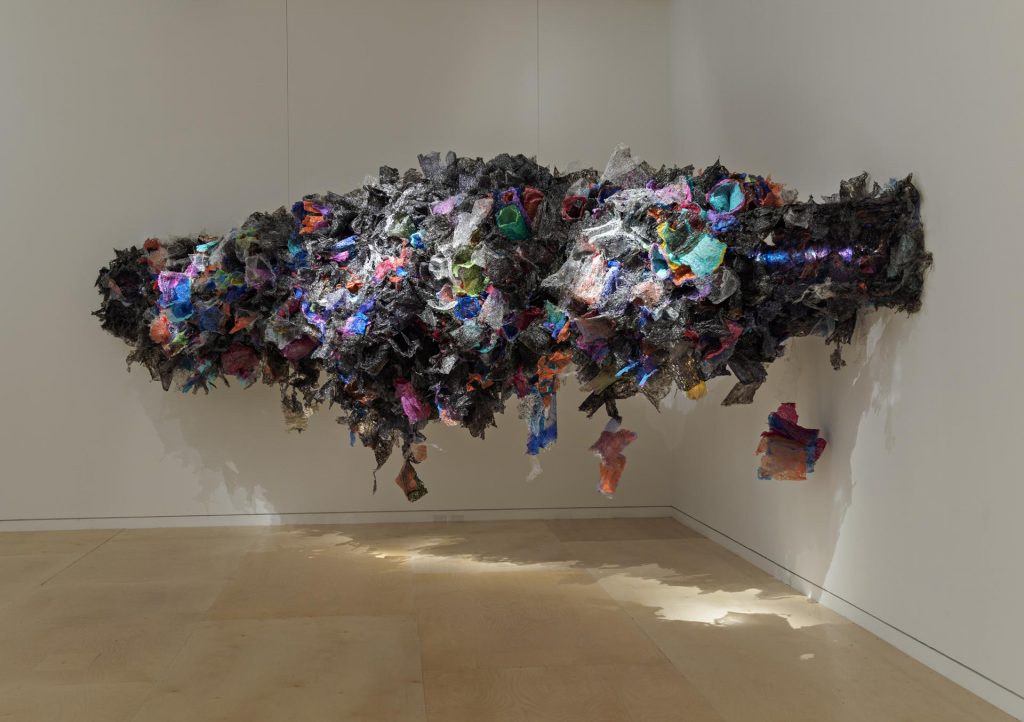
Untitled, Aaditi Joshi (Indian) 2016. Fused plastic bags, acrylic paint, LED lighting, and wooden armature.Courtesy of Artist and Gallery Maskara. Photograph by David Desouza. © Aaditi Joshi. Courtesy, Museum of Fine Arts, Boston.
I read that the production and use of plastic bags is banned in Maharashtra. Has the ban been effective? How do you gather the materials for your installations?
Well, the kind of bag that I use in my work wasn’t banned here. I’ve observed that carry bags are so common, used frequently in marketplaces, and those were type of bags that were banned. The thin, transparent plastic bags that I use in my work are purchased from wholesale marketplaces in Mumbai.
Your installations are often placed so as to disrupt the normal flow of people. Do you see these works as site specific? How does the work’s placement in a museum affect its significance?
No, that’s not purposely done!
While I do preliminary sketches, I randomly select the placement and form of the work. While I work on site, I the sculpture slowly starts to take a monumental form, so that some part of it naturally touches the ground and also expands towards the sky. So as it develops into more and bigger, it requires the viewer to bend down to see the other side of it, or maybe part of the work touches the viewer’s body or skin as they walk or pass by. I invite people to walk around and feel my work from up close.
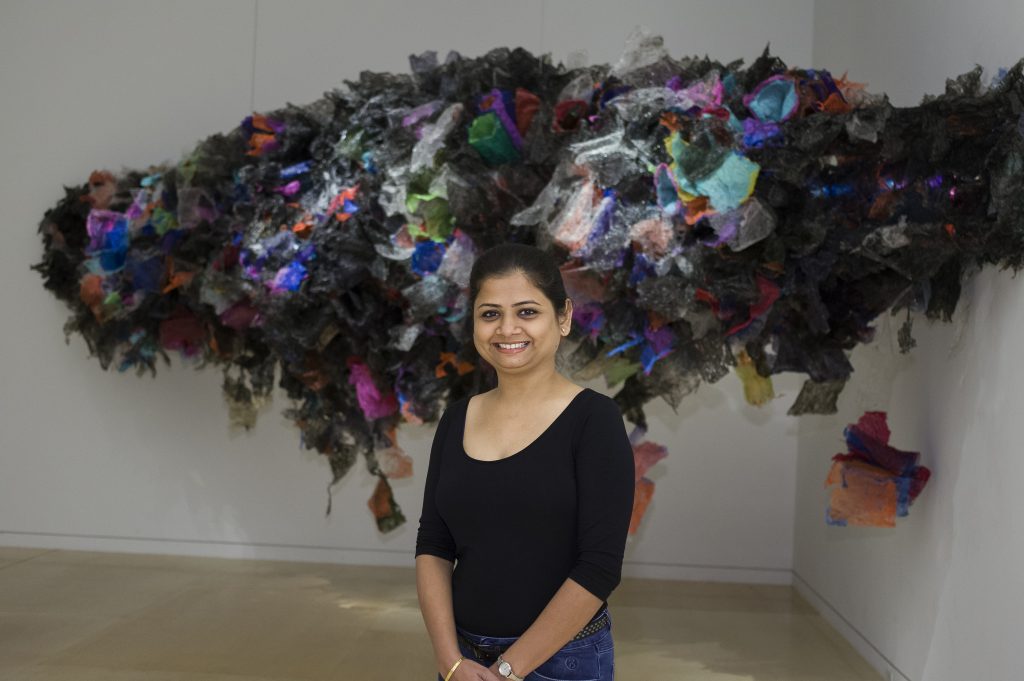
Untitled, Aaditi Joshi (Indian) 2016. Fused plastic bags, acrylic paint, LED lighting, and wooden armature.Courtesy of Artist and Gallery Maskara. Photograph by David Desouza. © Aaditi Joshi. Courtesy, Museum of Fine Arts, Boston
I built my entire work on site; my current practice is about studying the horizontal form and creating tensions between two walls. When the viewer comes closer to the work they feel the colors, depth, and crystallized feel I create with a kind of light arrangements. So in a way, light plays an important role in my work.
I am inspired by trash around me and my day to day experiences while walking on the road. I am affected by the presence of plastic in garbage, and how it gets to the sea, making animal and marine life suffer. Plastic, its presence in waste, and how people avoid walking by waste and hold their nose if they do, affect me.
Museum shows are definitely significant because they have a much wider audience than a usual gallery space, and the visitors will come in huge crowds, or with a tour or a guide, so exposing my work to a larger viewership is a really important aspect of my practice. Even though I’m back in my hometown of Mumbai, I can still see how people are enjoying the work at the MFA via social media.
Are these works portraits of particular places or landscapes?
Well, my work is all about the overall impressions of my mind, and my sculptures created from trash I feel like are landscapes of ‘garbage.’
I sometimes stop along the roadside to absorb the enormous hills and piles of trash. It disturbs me and pushes me to incorporate them into my artistic practice. Garbage is never attractive, and it doesn’t have a language of beauty. It’s always perceived as a mixture of dirt, dust, and pollution and is very unhygienic.
Garbage has a terrible smell—it always stinks—and consists of wet, dry, oily, and rusty content. Sharp objects are sometimes hidden in garbage, so it can be dangerous. No one likes to touch or feel garbage. It’s always ignored, bypassed, or overlooked.
Being a visual artist, when I look at garbage or a heap of trash, immediately my eyes see the many colors and fluid forms of the garbage, and these forms inspire me to created multicolored forms in my work.
Megacities Asia is on view at the Museum of Fine Arts, Boston through July 17.

